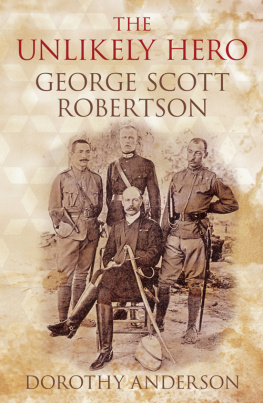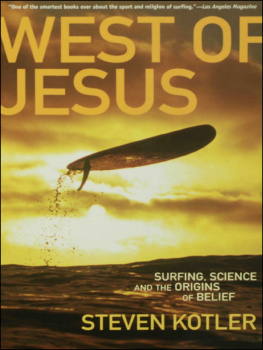
Contents
CHAPTER 1
Sir George Scott Robertson, K.C.S.I., was born on 22 October, 1852, at 1 New Park Street, Southwark, London, and died on 2 January, 1916, at 14 Cheyne Walk, Chelsea, London. A memorial service for him was held on 7 January in St Margarets Church, Westminster. It was fitting recognition of what had been a varied, sometimes unpredictable, but always successful life, with careers as surgeon, political administrator, businessman, and Member of Parliament.
Robertsons family background was modest, unassuming, not landed nor professional, but commercial, with his father engaged for many years in a business of little social standing, barely respectable. But this family, all born and brought up in London, had a geographical background and history which was important in structuring its approach to society and behaviour.
Some thirty years earlier, Robertsons grandfather, Thomas, had fled from the Orkney Islands, escaping from the press gang to take refuge in London. He settled in Southwark, married Catherine Long, also from the Orkneys, who kept the Shovel Public House in Stepney, and it was there in 1822, that Robertsons father, Thomas James, was born. The family moved south to Southwark, to the Moonrakers Public House in Great Suffolk Street. Thomas died early in 1823.
Catherine, with baby son, stayed on in Southwark as publican of the Moonrakers, which supported a reasonable livelihood for the two of them, and established a meeting place for the Orcadian community gathered about south London. There were also the visitors from the Islands. Many, including her brother, were with the Hudson Bay Company, calling every three years on reaching London. Some, who saw themselves as refugees from the Islands, presented problems, and there were several to whom she gave financial support. There were other more prosperous visitors, a cousin who reputedly owned his own ship, and another, captain of an East Indiaman. Over the years she proved a successful manager of the Moonrakers, with additional income provided from the ownership of tenement flats.
This was background in which Thomas James grew up, a busy, bustling life, with a strong commercial emphasis, enlivened and enriched by the visitors who brought with them colour and tales from outside south London, of ships and sea, and of the Islands far to the north. By the early 1840s he was ready to embark on his own business, setting up as a pawn-broker, and, shrewdly acknowledging the experiences of his mother, establishing his office at 1 New Park Street, next door to the Noahs Ark Public House. He married Robina Corston Scott at St Marys Church, Lambeth, on 3 November 1847. His wife had a family background similar to his own, born in London, where her parents had settled after their marriage in 1815 in Kirkwall. The pawnshop prospered, and their family of eight, three sons, five daughters, were brought up, not in affluence but in comfort.
Pawn broking was a not a business held in high regard, nor had the pawn broker any particular social status. By the 1850s, however, the trade had been regulated by law, and the old sleazy image was fading. Many pawnshops had become well organised financial businesses which included among their functions those of bankers to the working classes, providing services now much in demand. For the businessman, who could act with caution, had skill and patience in dealing with people, and could listen to tales of much woe while believing only so much, pawnbroking offered financial success: it was a business which required shrewdness, perspicacity, an eye for detail, and mental toughness.
All these were qualities which Thomas James Robertson had inherited, and, as a pawnbroker, were disciplined and strengthened. After twenty years he was ready to utilise his business experiences in another more specialised undertaking. The pawnshop was sold, and there was a move north to Hanover Square, and in that more affluent locality, he established a new business, as silversmith and jeweller. It was to be a family business: according to the 1871 census returns, his wife was also working as a silversmith with his eldest son as watchmaker. Within ten years there was another move, away from Belgravia, to Hammersmith. It is probable that this was not because of particular difficulties in managing a jewellers establishment, but more likely the choice of a less stressful occupation, the beginning of retirement. In the 1881 census returns, when both Thomas James and his wife were fifty nine, they were living in Hammersmith, and Thomas Jamess occupation was now that of clerk, his eldest son an accountant: Linton Villa, 114 Netherwood Road, Hammersmith, was to be their address until 1890. The transition from pawnbroker to commercial business man had, indeed, been a success, financially and socially; for his family as they grew up, there had been the bigger houses, better addresses, a measure of affluence, an improvement in social status, and opportunities for professional education.
The Orkney background was not forgotten, and through the Scott family, there were other tales (of Sir Anthony Scott and his son John, refugees from Culloden) and more family connections in the Islands and Scotland. All of these were reflected in Thomas Jamess family, in the upbringing of his eight children, and the close sibling relationships. From that background was inherited independence, self reliance, discipline, a demand for education; and also social dignity, a consciousness of personal value.
These two strands, the inheritance of his Orkney background and the everyday practicalities of commerce and careful husbandry, comprised the family background of George Scott Robertson, and were to be with him all his life, serve him throughout his career.
He was the second son, the third child. His early education and that of his brothers was at school in London and in Edinburgh, under the care of an Orkney relative. His early decision was for a career in medicine. In London, in October 1869, aged seventeen, he was apprenticed to the Apothecary Beer, in Dover Street, Piccadilly, and by July 1876 he had completed his training, submitted to the examination, and obtained his diploma as Licentiate of the Society of Apothecaries (L.S.A.). He had also been attending lectures at the Westminster Hospital Medical School, and qualified as a Member of the Royal College of Surgeons in 1877 (M.R.C.S.). In all he had studied and trained for seven years.
The next step was to decide his future as doctor and surgeon, in which field of medicine to work. His choice was to enter the Indian Medical Service, to make use of his qualifications and training as an army surgeon.
Notes
Information about the Robertson family is from the notes and jottings of GSR, in which he set out his own family research, with recollections and details as told by his parents; a copy of these notes was received from Ian Robertson, of Norfolk, whose grandfather was GSRs brother. The notes have proved invaluable in revealing family movements between the Orkney Islands and south London. Much of the detail of names and dates in the notes has been confirmed with research into rate books, church baptism records, and early maps, through the assistance of the Southwark Library Local History Archivist, and local researchers. Other information has come from the Orkney Family History Society.
Listed as a registered pawn-broker in the London Trade Directories, 1845.
See Hudson, K., Pawnbroking: an aspect of British social history (1982); Tebbutt, M., Making ends meet: pawn broking and working-class credit (1983)
CHAPTER 2
Next page








